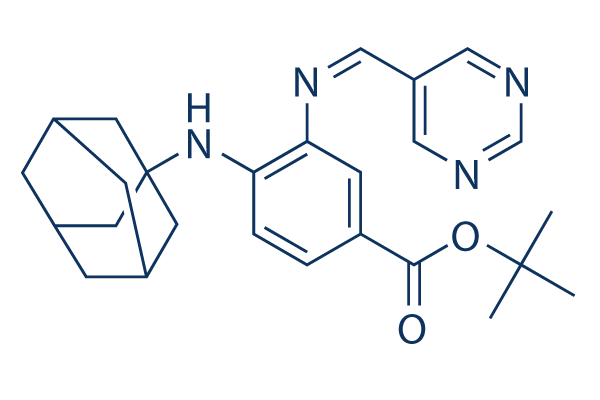| Cas No.: | 1793052-96-6 |
| Chemical Name: | 3-[(Z)-(5-Pyrimidinylmethylene)amino]-4-(tricyclo[3.3.1.13,7]dec-1-ylamino)-benzoic acid, 1,1-dimethylethyl ester |
| Synonyms: | tert-butyl 4-(1-adamantylamino)-3-(pyrimidin-5-ylmethylideneamino)benzoate;3-[(Z)-(5-Pyrimidinylmethylene)amino]-4-(tricyclo[3.3.1.13,7]dec-1-ylamino)-benzoic acid, 1,1-dimeth |
| SMILES: | O(C(C([H])([H])[H])(C([H])([H])[H])C([H])([H])[H])C(C1C([H])=C([H])C(=C(C=1[H])/N=C(/[H])\C1=C([H])N=C([H])N=C1[H])N([H])C12C([H])([H])C3([H])C([H])([H])C([H])(C([H])([H])C([H])(C3([H])[H])C1([H])[H])C2([H])[H])=O |
| Formula: | C26H32N4O2 |
| M.Wt: | 432.5579 |
| Purity: | >98% |
| Sotrage: | 2 years -20°C Powder, 2 weeks 4°C in DMSO, 6 months -80°C in DMSO |
| Description: | SRS16-86 is a potent inhibitor of ferroptosis[1]. SRS16-86 is more stable than more stable to metabolism and plasma than Ferrostatin-1 in vivo. SRS16-86 can be used for renal ischemia-reperfusion injury (IRI) and spinal cord injury (SCI) research[2][3]. |
| In Vivo: | SRS16-86 (intraperitoneal injection; 2 mg/kg; 15 min before the onset of surgery) protects mice from functional acute renal failure and structural organ damage after ischemia–reperfusion injury (IRI)[2]. SRS16-86 (intraperitoneal injection; 2 mg/kg; 4 weeks) combination therapy with [Nec-1+SfA] is superior in the prevention of renal IRI compared with the double-combination therapy with [Nec-1+SfA]. Addition of 16-86 reduces plasma levels of serum urea and serum creatinine in IRI mice model[2]. SRS16-86 (intraperitoneal injection; 15 mg/kg; once a day; 7 days) enhances functional recovery after SCI, it decreases the levels of proinflammatory cytokines and the inflammatory adhesion factor in injured spinal cord in rats[3]. Animal Model: Renal IRI model Dosage: 2 mg/kg; 15 min before the onset of surgery Administration: Intraperitoneal injection; 2 mg/kg; 15 min before the onset of surgery Result: Was protective from renal IRI. Animal Model: Renal IRI model Dosage: 2 mg/kg Administration: Combination with Necrostatin-1/Sanglifehrin A; 2 mg/kg; 4 weeks Result: Further increased the protective effect of [Necrostatin-1/Sanglifehrin A] combination therapy in renal IRI model. |
| In Vitro: | SRS16-86 (1 µM; 24 hours; in the presence or absence of erastin) inhibits ferroptosis in HT-1080 cells and NIH 3T3 cells[2]. |
| References: | [1]. Sam Hofmans, et al. Novel Ferroptosis Inhibitors with Improved Potency and ADME Properties. J Med Chem. 2016 Mar 10;59(5):2041-53. [2]. Andreas Linkermann, et al. Synchronized renal tubular cell death involves ferroptosis.Proc Natl Acad Sci U S A. 2014 Nov 25;111(47):16836-41. [3]. Yan Zhang, et al. Ferroptosis inhibitor SRS 16-86 attenuates ferroptosis and promotes functional recovery in contusion spinal cord injury. Brain Res. 2019 Mar 1;1706:48-57. |

 To enhance service speed and avoid tariff delays, we've opened a US warehouse. All US orders ship directly from our US facility.
To enhance service speed and avoid tariff delays, we've opened a US warehouse. All US orders ship directly from our US facility.




















